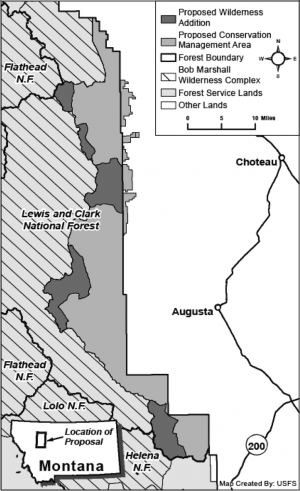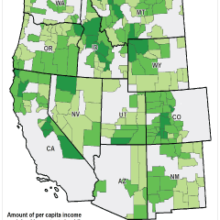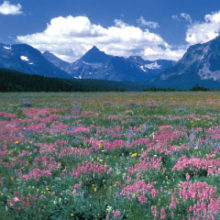The report, “Montana’s Rocky Mountain Front” (500K PDF), analyzes the recent history and current conditions for the Front’s land, people, and economy. The study reviews the proposed Rocky Mountain Heritage Act and its potential impact on the Front’s economic future, then discusses how to best leverage the area’s existing economic assets — stunning landscapes, transportation hubs, relatively high average earnings and per capita income, and overall stability — to enhance future economic growth and prosperity.
This page graphically summarizes the study. For more detail, see the Full Report or the Summary and Discussion.
Summary Findings
The economy of the Rocky Mountain Front (maps at bottom) has experienced steady, stable, long-term growth, especially compared to many other parts of Montana and the West.
- The population along the Front has grew 24% from 1970 to 2010 (121,844 to 151,201 people). Most recent population gains are due to natural change (births minus deaths) and not in-migration. The population along the Front is is relatively well-educated and getting older.
- The economy of the Front also has experienced slow, steady, long-term growth. From 1970 to 2010, employment along the Front grew 75%, from 57,260 to 100,203 jobs. Real personal income grew 109%, from $2.9 billion to $6.0 billion. Per capita income has grown steadily over the long term, rising 68% in real terms, from $23,627 in 1970 to $39,749 in 2010 — higher than the comparable figure for Montana, which was $36,160 in 2010.
- The region has below average unemployment — 5.7% in 2011, largely due to a relatively diverse services economy, an above average share of government employment, and the growth of non-labor sources of income, including retirement and investments, among the fastest growing sources of personal income, totaling $2.3 billion or 38 percent of total personal income in 2010.
- During the past decade, the fastest growing private sectors were higher-paying services-related industries: health care and social assistance (2,126 new jobs), professional and technical services (822 new jobs), and finance and insurance (983 new jobs). In 2010, the largest sectors overall in the Front region were: health care and social assistance (12,216 jobs), retail trade (11,290), and accommodation and food services (7,475).
- Established measures of economic well-being are rising on the Front. Real earnings per job rose from $38,770 in the year 2000 to $44,527 in 2010, in real terms. By comparison, average earnings for the state as a whole were $38,690 in 2010. Per capita income rose in real terms from $23,627 in 1970 to $39,749 in 2010 — also higher than the comparable figure for the state as a whole, which was $36,160 in 2010.
- Non-labor sources of income have been among the fastest growing sources of personal income for all three counties of the Front region. In 2010, non-labor income was the largest source of personal income on the Front, totaling $2.3 billion: 38 percent of total personal income.
Real Avg. Earnings per Job & Per Capita Income, Rocky Mountain Front
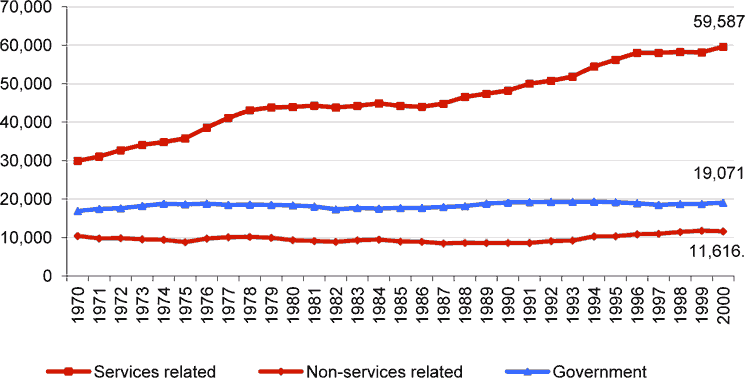
Agriculture Stable, Tourism Growing
Agriculture remains the Front’s predominant land use. In 2009, there were 4,678 farm and ranch jobs in all three counties. The share of total employment held by farming and ranching varies: Cascade County 2.1%, Lewis and Clark County 1.5%, and Teton County 20.4%. Travel, tourism, and recreation play a significant role in the area’s economy. In 2009 along the Front, there were approximately 10,622 private wage and salary jobs in all travel and tourism sectors (19% of total private wage and salary employment).
Land Ownership, Percent of Total Land Area, Rocky Mountain Front
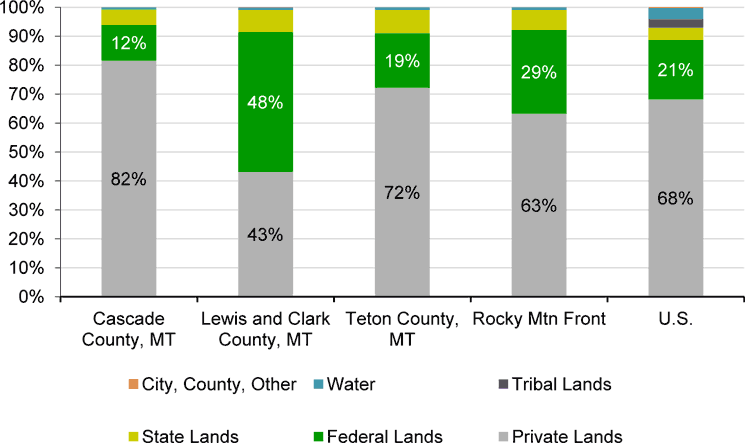
Front Hunting Contributes $10 Million
Expenditures by hunters along the Rocky Mountain Front held steady through the past several years, despite difficulties in the broader economy. In 2006, at the peak of the last business cycle, sportsmen hunting along the Rocky Mountain Front spent $9.8 million. This grew to $10.4 million in 2008 mid-recession, falling only slightly in 2011 to $9.6 million. Of the $9.6 million, out-of-state visitors spent more than $4.9 million; the remainder came from Montana residents.
The Economic Role of Public Lands
Research increasingly shows travel, tourism and outdoor recreation activities are part of a larger amenity economy related to public lands, driving growth in the rural West and along the Front. The federal public lands and natural amenities found in western states provide an economic advantage — these lands attract people and business in a range of sectors critical to our economic future.
Today in the West, protected federal lands, such as national parks, monuments, and wilderness areas, are associated with higher rates of job growth. From 1970 to 2010 non-metropolitan western counties with more than 30 percent of their land base in federally protected status increased jobs by 345 percent. During this same period, non-metro counties with no protected federal lands increased employment by only 83 percent.
The Heritage Act and the Region’s Economic Future
The proposed Rocky Mountain Front Heritage Act would designate 67,000 acres of United States Forest Service land as Wilderness and 208,112 acres of Forest Service and Bureau of Land Management land as a Conservation Management Area (CMA). This would bring a beneficial economic impact to the area, helping preserve the hunting, tourism, and recreation sectors.
The proposed legislation would support current and continued ranching and commercial public land use, while helping combat noxious weeds in multiple jurisdictions — especially important consideration in Teton County where 20% of the employment in agriculturally related and 79% of the county’s land is in farm and ranch production.The Heritage Act is one of several factors likely to influence the long-term economic health of the Front. The spectacular public lands give the region a natural competitive advantage, providing considerable tourism and recreation income. The Front’s public lands attract for business owners, workers, and retirees. As the services sector continues to drive growth in the West, an increasing number workers will be able to perform their jobs from a variety of locations, including the Front.
What Next?
The Front region should market the area’s high quality of life and economic stability, possibly targeting business owners visiting the Front as tourists. Such outreach would encourage “visit and stay” situations where workers, employers or retirees visit Great Falls, Choteau, or Augusta, enjoy their stay, and decide to invest in, or move to, the community. Some of this effort must come from local officials and business leaders.
The Front is a gateway to the area’s incredible recreation opportunities. Recent improvements in Great Falls and Helena air service are vital for growth in tourism and for local businesses seeking access to new clients and customers.
Finally, improving educational opportunities and retaining people must remain a priority. The Front’s educational attainment for a bachelor’s degree is on par with national and state averages, and the region has a higher than average percentage of residents with a high school degree. Education levels closely correspond to unemployment rates and future earnings potential, The Front region should work to ensure its workforce is adequately prepared to succeed in our rapidly changing economy.
The Rocky Mountain Front Region
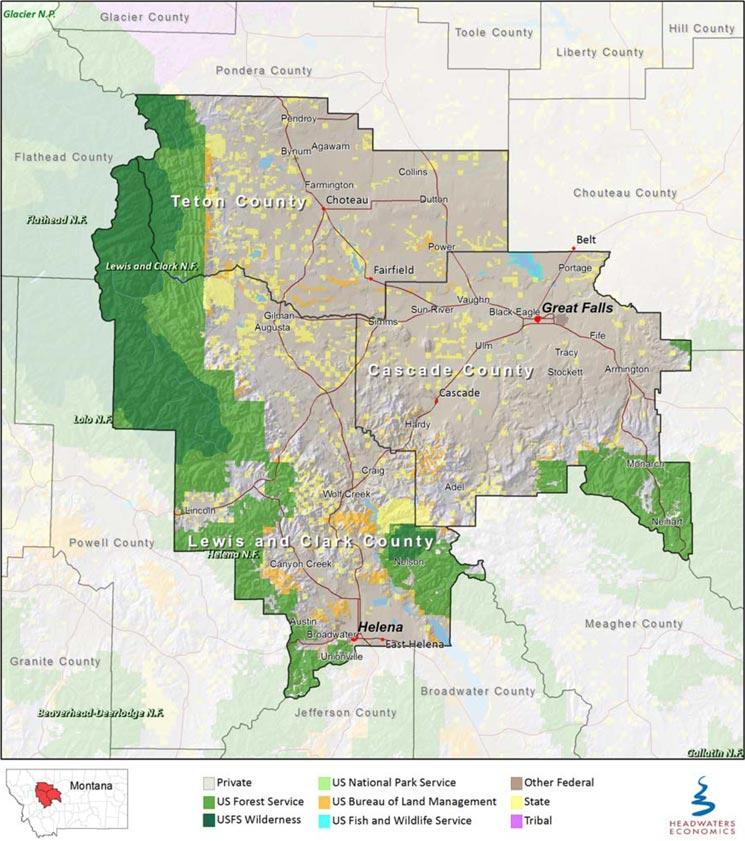
The Rocky Mountain Front region is defined in this report as the roughly 100-mile stretch of land on the east side of the Continental Divide that includes Cascade, Lewis and Clark, and Teton Counties where the plains meet the mountains just south of Glacier National Park.
Headwaters Economics completed this report at the request of The Coalition to Protect the Rocky Mountain Front.
